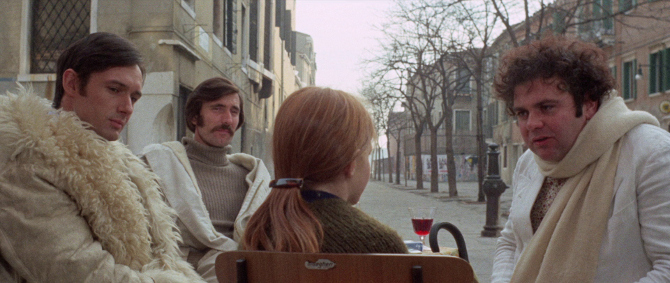Like a copycat killer, it is somehow unusual and rather suspicious that anytime a good film idea hits production, it seems like there is another similar project coming down the pipeline. . . sometimes referred to as ‘twin films’, countless examples exist – White House Down and Olympus Has Fallen, Hitchcock and The Girl, The Prestige and The Illusionist, Friends With Benefits and No Strings Attached, Darkest Hour and Churchill, The Descent and The Cave (anyways, you get the idea). Another intriguing example finds the horror classic Don’t Look Now having a doppelganger in the 1972 Aldo Lado directed giallo Who Saw Her Die? – though don’t jump to conclusions as to which one is the knock-off.
Released a year prior to the 1973 feature, Who Saw Her Die? also finds itself set in the eerily beautiful city of Venice, where a couple is dealing with the death of their child. With numerous similarities, like a water-set funeral and an intimate sex scene, and though the set up and settings are similar, in many ways, they are separate entities.
Following sculptor Franco Serpieri (George Lazenby – no, he did not only star in On Her Majesty’s Secret Service) and his wife Elizabeth (Anita Strindberg), they are not exactly on good terms. . . living in different cities, she is questioning whether she wants to continue with the relationship.
While their daughter Roberta (expressive Nicoletta Elmi) visits her father in the city of canals, she is unknowingly stalked by a veiled character, ominously all in black (including the troped gloves), who is a child killer (yet strangely, only of red headed girls). One of the stunning set pieces finds Roberta the centre of a ‘Ring Around the Rosie’ style game, the children singing an outrageously macabre song as they circle her while the killer watches intensely (actually, the song the children sing is where the film gets its title from).
Through the first act, we watch in horror as the calls keep getting closer (Ennio Morricone’s score, that of a children’s choir, may sound like it should be sweet and innocent, but, at its core, it contains the threat of creeping anxiety), in our gut, we know that the film’s title is a reference to this most heinous act.
Dealing with the grief of losing a child in a most horrific way, Elizabeth looks to rekindle some hope by reuniting with her husband, yet Franco cannot do anything but stew in the pain. Instead of trying to find some solace and move on with his wife, he turns amateur sleuth, attempting to piece the mysteriously sordid puzzle together.
Investigating his way through the unique city, most would immediately expect to see the packed streets and canals. . . a hustling hub of tourists and busy dwellers. . . yet, Lado wisely sets this picture in the winter months. Fog settles upon the now quiet locale, the ominously empty streets giving an air of doom and gloom that is only befitting of the couples’ unbearable situation. Filled with unseeable ghosts, it seems like the few people remaining deserve to be haunted by some sort of spectre. Obviously a giallo (in many ways its closest comparison would be Lucio Fulci’s Don’t Torture a Duckling), it is not so focussed on the wild flourishes and over-the-top visuals, instead fermenting in its own setting, the city atmosphere and grief its main driving points (though that is not to say that there are not some clever murder designs – from a fantastic scene in a movie theatre, to the final set piece, this one has some wow moments).
Hands lurk, eyes gaze, untrustworthiness oozes, and mystery looms (even the touch between two human beings never seemed so ominous) in every nook or office as the sculptor meets with a slew of locals, including one of his wealthy benefactors, industrialist Serafian (Adolfo Celi – another James Bond icon who starred as villain Largo in Thunderball), his slightly off-putting journalist pal Cuman (Piero Vida), a sordid couple in Filippo (Peter Chatel) and Ginevra (Dominique Boschero) – let me just say that their relationship is questionable in a wholly different way from the narrative’s main couple, sketchy lawyer Bonaiuti (José Quaglio), or involved priest, Father James (Alessandro Haber). . .basically, it feels like anyone could be the warped killer.
In many ways a mood piece, many people will be somewhat surprised at Lazenby’s acting chops. Known for his fluffy singular Bond role, the actor (having lost thirty-five pounds and porting a thick mustache in this one), is fully immersed in the grieving process. . . anger, wrath, pain and anguish pushing him forward in this dangerous investigation. Perhaps the most moving scene finds the couple laying in bed after the slow, attempt-for-self-healing love making, the camera moving back and forth between them as they wallow in an uncomfortable fugue (before it ends with the pair framed together in their sorrow).
Standing as a quality giallo, a fascinating double feature companion piece for Don’t Look Now, and a dark mood piece, Who Saw Her Die? is a mystery/thriller that holds up quite well. The last thing that I would like to note is an impressive sequence set in a giant dilapidated structure (formerly the Molino Stucky Flour Mill, it has now been restored as a hotel), the fog hindering everyone’s view (including our own) as a cat and mouse chase occurs over its many floors – it is a masterclass in creative shots, building suspense, visual splendour and storytelling. So, give this picture your blessing by tracking it down, it is well worth the steeplechase.
This film can be watched in Italian (with a touch of French) with English subtitles, or in dubbed English (though that is a frustrating experience. . . as it is not Lazenby who voices the character of Franco)



